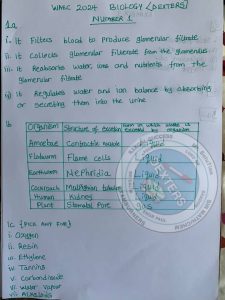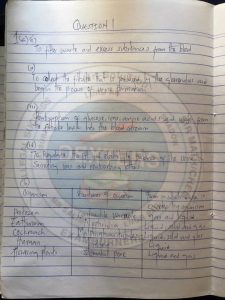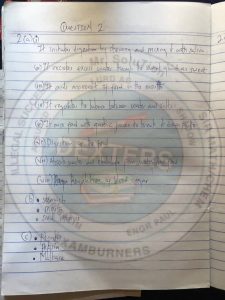Biology Waec Answers 2024
(2a)
(i) Mouth: The mouth’s role is in the mechanical breakdown of food through chewing and the beginning of chemical digestion through the action of enzymes like amylase in saliva.
(ii) Skin: The skin’s role is in regulating body temperature by sweating to cool down the body when it’s overheated, as in this case.
(iii) Tongue: The tongue helps with the manipulation of food during chewing and swallowing.
(iv) Kidney: The kidney’s role is in filtering waste products from the blood and regulating fluid balance, which may be affected by the meal’s salt content.
(v) Stomach: The stomach’s role is in further mechanical and chemical digestion of food, particularly through the action of gastric juices containing enzymes like pepsin.
(vi) Small intestine: The small intestine’s role is in the absorption of nutrients from digested food.
(vii) Large intestine: The large intestine’s role is in the absorption of water and electrolytes from undigested food and the formation of feces.
(viii) Liver: The liver’s role includes producing bile, which aids in the digestion and absorption of fats.
(2b)
(i) the mouth
(ii) stomach
(iii) small intestine
(2c)
(i) amylase (in saliva and pancreatic juices)
(ii) pepsin (in gastric juices
(iii) lipase (in pancreatic juices).
(2d)
(i) glucose (from the breakdown of cassava starch by amylase)
(ii) fatty acids (from the breakdown of fats in groundnut soup by lipase).
(2e)
(i) Excess salt in the meal might lead to dehydration or exacerbate conditions like high blood pressure.
(ii) Three advantages the individual would derive from the meal could include energy from carbohydrates in cassava, protein from groundnuts, and various vitamins and minerals from both components of the meal.




(1ai)
(PICK ONE)
(I)Filtration of blood to form urine.
(I) Regulation of blood pressure by controlling filtration rate.
(III) Removal of waste products from the blood.
(1aii)
(PICK ONE)
(I) Collects the filtrate from the glomerulus.
(II) Prevents large molecules such as proteins from entering the tubule.
(III) Initiates the process of urine formation.
(1aiii)
(PICK ONE)
(I) Reabsorption of glucose, amino acids, and water from the filtrate.
(II) Secretion of hydrogen ions and organic acids into the filtrate.
(III) Regulation of pH balance by reabsorbing bicarbonate ions.
(1aiv)
(PICK ONE)
(I) Regulation of potassium and sodium ions through reabsorption and secretion.
(II) pH regulation by secreting hydrogen ions and absorbing bicarbonate ions.
(III) Reabsorption of water and calcium ions under hormonal control.
(1b)
COMING SOON
(1c)
(PICK FIVE)
(i) Oxygen
(ii) Carbon dioxide
(iii) Water vapor
(iv) Organic acids (e.g., citric acid)
(v) Ethylene
(vi) Resins
(vii) Latex


Nice one and good works to you guys